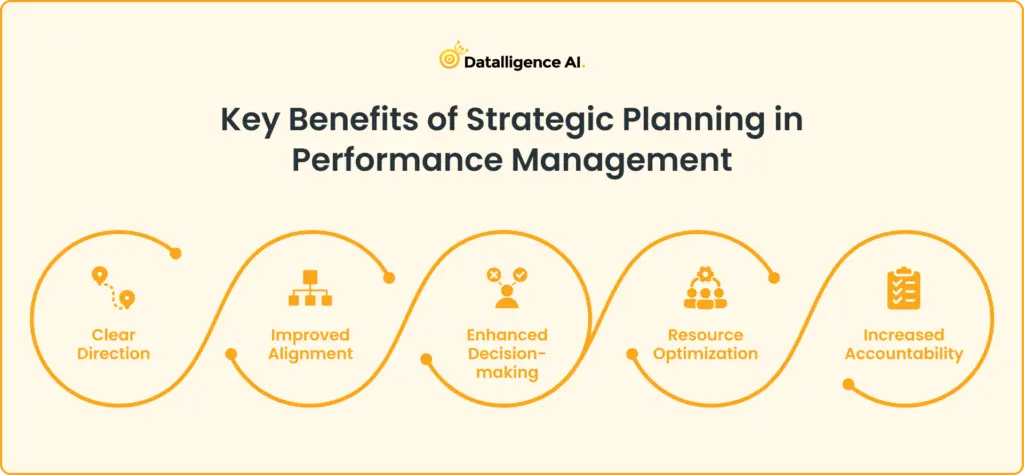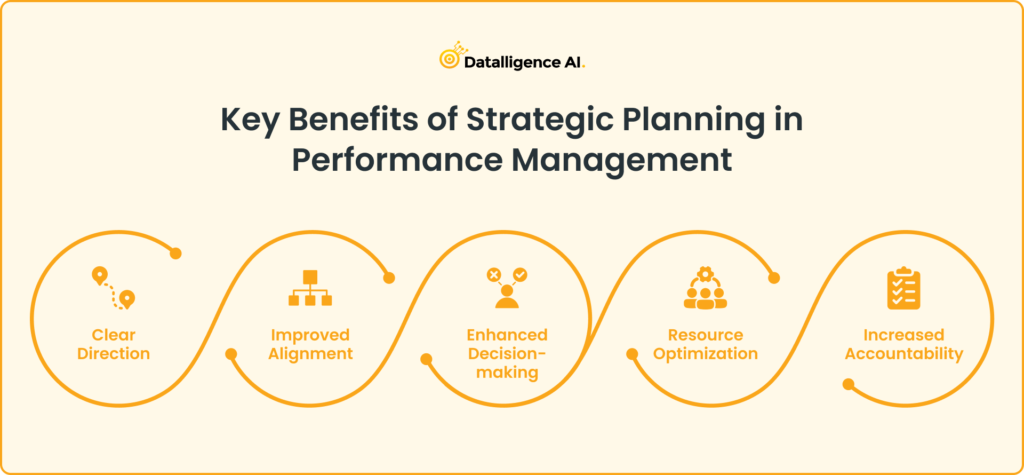Ever wondered what fuels the long-term success of top-performing companies? One of the core drivers is the seamless integration of strategic planning in performance management.
This isn’t just a corporate buzzword—it’s a practical, proven approach that aligns big-picture goals with day-to-day execution.
Strategic planning lays out the vision, priorities, and roadmap for the business. It answers questions like:
Where are we heading?
What do we want to achieve in the next quarter or year?
What are our top priorities?
Performance management, on the other hand, ensures that every team, department, and individual is aligned with that plan. It tracks progress, monitors outcomes, and enables continuous improvement.
When you bring them together, strategic planning in performance management ensures:
Clear alignment between strategy and execution
Consistent tracking of progress against key objectives
Real-time feedback and course correction
Better resource allocation and accountability
This blend empowers teams to move with purpose and clarity—no guesswork, no wasted effort. It transforms ambition into action and strategy into measurable results.
If you’re serious about driving focused growth, strategic planning in performance management isn’t just helpful—it’s essential.
Dive with us on this journey to understand how strategic planning performance measurement and strategic performance management systems play pivotal roles in driving success.
What is Strategic Planning
Strategic planning is a systematic process by which organizations define their future direction and make decisions on allocating their resources to pursue this strategy. Essentially, it's about determining where an organization wants to go in the next few years and how it's going to get there. It requires a vision of the future, an understanding of the present circumstances, and the steps required to bridge the gap between the two.
To understand this concept further, here are key components that underlie strategic planning

Vision and Mission
These serve as the north star for the entire organization. While the vision statement describes the future desired state of the organization, the mission statement explains its fundamental purpose, outlining why the organization exists.
Situational Analysis
This involves examining the internal and external factors affecting the organization. Tools like SWOT analysis (Strengths, Weaknesses, Opportunities, Threats) are commonly used.
Goal Setting
Goal Setting is broad, long-term aims that define the desired outcome. They provide direction and help in the creation of a strategic vision.
Objectives
These are specific, measurable, short-term achievements that help in accomplishing broader goals. They provide clarity on what needs to be achieved within a particular timeframe.
Strategies and Tactics
While strategies give a broad approach to achieving the set objectives, tactics are specific actions that need to be taken to implement those strategies.
Implementation
This involves putting the strategic plan into action. It may entail resource allocation, organizing tasks, and ensuring that everyone in the organization is on board.
Monitoring and Review
No strategic plan is complete without a system to check its progress. Organizations need to continually review and adjust their strategies based on the feedback and results they get.
In essence, strategic planning acts as a roadmap for organizations, guiding them toward a desired future while navigating the complexities of the current environment. It's a disciplined effort that produces decisions and actions leading to a successful future.
Relation Between Strategic Planning and Performance Management
The interplay between Strategic Planning and Performance Management forms the backbone of organizational success. While strategic planning provides a roadmap, outlining an organization's vision and defining its objectives, performance management ensures that this vision is translated into actionable steps and monitored for results. Together, they form a harmonious cycle where planning informs performance actions, and the feedback from performance subsequently refines the strategic direction.
This symbiotic relationship ensures that an organization remains agile, aligned, and purpose-driven in an ever-evolving business landscape.
What Role Does Strategic Planning Play In Performance Management
Strategic planning in performance management sets the direction and benchmarks for organizational success. It begins by laying out a clear vision and goals, which performance management uses as a yardstick to measure progress. This planning aligns individual roles with overarching organizational objectives, ensuring cohesive efforts across the board. The allocation of resources, crucial in achieving set objectives, is guided by the strategic plan. As performance is continuously monitored, feedback refines the ongoing strategic endeavors. This interplay ensures that the organization remains focused on its goals, fosters accountability, and makes informed adjustments as it navigates its path to success.
Key Benefits of Strategic Planning in Performance Management

The integration of strategic planning with performance management offers numerous benefits to organizations. Here are the key advantages:
Clear Direction
Strategic planning acts as the organization's compass. Establishing a distinct vision and set of objectives ensures that all endeavors, whether big or small, steer towards a common goal. This clarity eliminates ambiguity and provides purpose to every task, project, or initiative.
Improved Alignment
In large organizations, it's easy for departments or teams to work in silos, potentially pulling in different directions. Strategic planning bridges this gap. It ensures that individual tasks and departmental goals resonate with the company's larger mission, fostering synergy and a united effort.
Enhanced Decision-making
The presence of a strategic framework aids decision-makers. Instead of relying on gut feelings or short-term gains, they have a reference point that aligns decisions with the long-term vision. This consistency in decision-making ensures that the organization stays on its intended path and avoids costly detours.
Resource Optimization
Resources, be it time, money, or manpower, are often limited. Strategic planning ensures that these resources are directed where they're needed most, preventing wastage and ensuring that priority areas receive the attention they deserve.
Increased Accountability
With clear objectives and metrics derived from strategic planning, every team member can see how their efforts contribute to the bigger picture. This transparency fosters a culture where individuals take ownership of their roles, leading to enhanced responsibility and a drive to meet or exceed set benchmarks.
Challenges in Implementing Strategic Performance Management
Numerous challenges can arise, potentially diverting the course of action and affecting the desired outcomes.
Here are 10 primary challenges faced when implementing strategic performance management:
- Aligning individual performance with organizational goals.
- Overcoming resistance to change within the organization.
- Ensuring clarity and understanding of the strategic vision across all levels.
- Maintaining flexibility while adhering to a set strategy.
- Gathering accurate and relevant data for performance measurement.
- Addressing gaps between current capabilities and strategic requirements.
- Managing complexities of integrating various performance management tools.
- Avoiding overemphasis on short-term results at the expense of long-term strategy.
- Ensuring continuous communication and feedback loops.
- Adapting to external factors and rapidly changing market conditions.
Performance Excellence Through Strategic Planning with Datalligence
At the crossroads of strategic planning and performance excellence lies Datalligence —a tool designed to elevate organizational success. Datalligence isn't just another management tool. It provides:
- Real-time performance tracking, ensuring immediate alignment with strategic goals.
- It promotes collaborative goal setting, engaging teams in shared organizational visions.
- With built-in feedback mechanisms, it facilitates timely communication and performance enhancement.
- Its analytics feature provides data-driven insights for informed decision-making.
- Seamless integration with other enterprise tools offers a holistic approach to performance management.
Together, these features make Datalligence an invaluable ally in translating strategic planning into measurable and commendable performance outcomes.
Conclusion
Strategic planning and performance management are twin pillars holding up the edifice of organizational success. While the former charts the path, the latter ensures we walk it effectively. For organizations aiming to optimize this interplay, guidance from seasoned experts can be invaluable. If you're looking to elevate your strategy and performance dynamics, our team of experts and coaches is ready to assist. Connect with us and take confident strides toward your organization's future.











